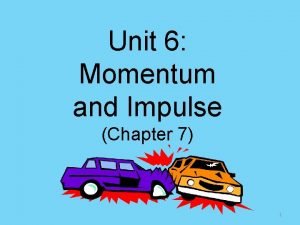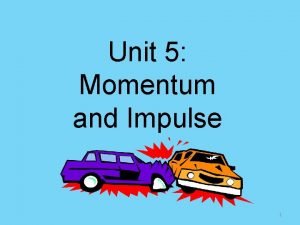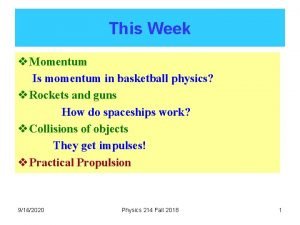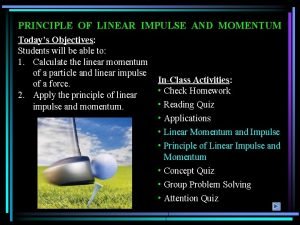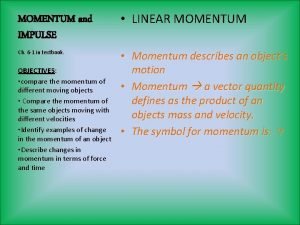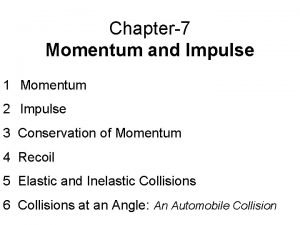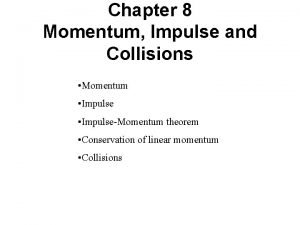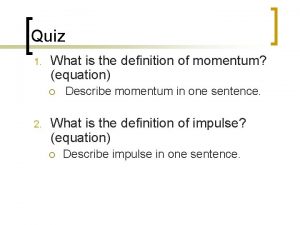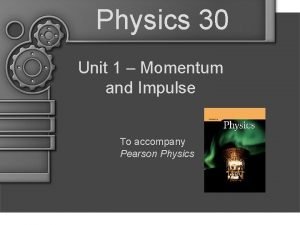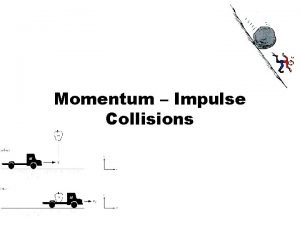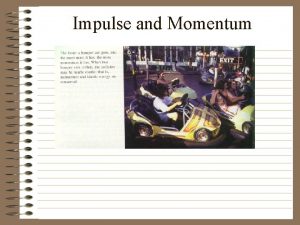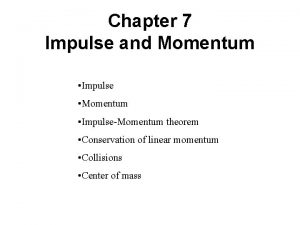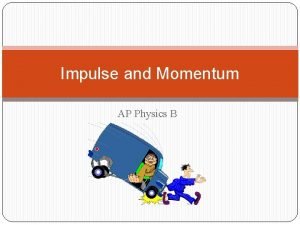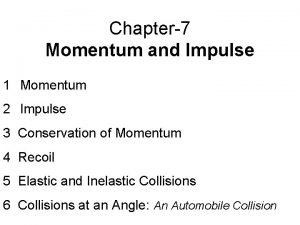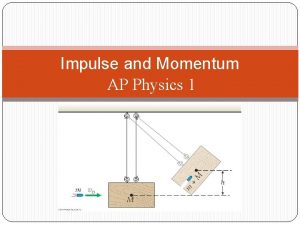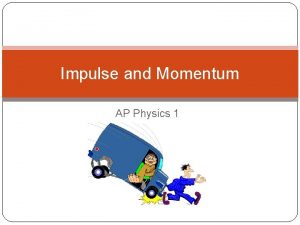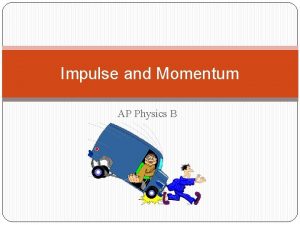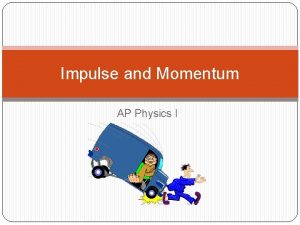Chapter 6 Momentum and Impulse Momentum The product















- Slides: 15

Chapter 6 Momentum and Impulse

Momentum The product of an object’s mass and velocity: p = mv Momentum, p, and velocity, v, are vector quantities, meaning they have magnitude and direction. The units for momentum are kg * m /s.

Momentum Examples… A 61 -kg man is traveling north in a 3200 kg car at 15 m/s. What is the momentum of the man? What is the momentum of the car? What is the total momentum of the man and car together? How fast must an 11, 000 -kg truck travel to have the same momentum as the man and the car in the previous problem?

Impulse Since a net external force changes the velocity of an object, it also changes the object’s momentum. If a net external force, F, is applied to an object for a certain time interval, Δt, then FΔt is the impulse of the force. Impulse equals the object’s change in momentum. FΔt = Δp or FΔt = mvf - mvi

Force and Momentum Examples A 145 -gram baseball is thrown to the right at 17 m/s. The first baseman catches the ball and brings it to rest in 0. 013 s. What force does the first baseman exert on the ball? A 7. 1 -kg piece of wood is dropped from a cliff 83 meters above the ocean. What is the velocity of the wood when it hits the water? If the water exerts an upward force of 140 N on the piece of wood, how long will it take for the piece of wood to come to a stop?

Stopping Distance Examples A 3200 -kg car is traveling east at 14 m/s when the driver steps on the brake pedal. The brakes apply a force of 9400 N to the west. How far does the car travel before it comes to a stop? In the previous problem, what is the car’s velocity 1. 0 second after the brakes are applied? How far has it traveled after 1. 0 second? 560 kg of cargo is loaded into the back of the car in the previous problem. If the same brake force is applied, how long will it take the car to come to a stop and how far will it go?

Conservation of Momentum The total momentum of two interacting objects remains constant (friction is disregarded): m 1 v 1, i + m 2 v 2, i = m 1 v 1, f + m 2 v 2, f

Conservation of Momentum Examples A 72 -kg man jumps off of a 327 -kg boat that is at rest. His velocity is 3. 8 m/s to the east. What is the velocity of the boat after the man’s jump? A cue ball and the 8 -ball both have a mass of 160 g. The cue ball is traveling 1. 3 m/s when it strikes the 8 -ball, which is initially at rest. What is the final speed of the 8 ball if the final speed of the cue ball is 0. 5 m/s in the same direction? A baseball player swings a 0. 95 -kg bat to hit a 145 -gram baseball that is traveling 17 m/s towards the batter. The speed of the bat is 15 m/s before hitting the ball and 5 m/s after. What is the velocity of the baseball immediately after impact?

Perfectly Inelastic Collisions “A collision in which two objects stick together and move with a common velocity after colliding. ” (p. 222) m 1 v 1, i + m 2 v 2, i = (m 1+ m 2)vf

Perfectly Inelastic Collision Examples… A 1350 -kg car traveling 12. 0 m/s collides with a 4200 -kg truck at rest. The car and truck stick together and move together after the collision. What is the final velocity of the two vehicles? A 45 -kg student runs and jumps at 4. 0 m/s onto a stationary skateboard. The student and skateboard move together at 3. 8 m/s. What is the mass of the skateboard?

Objects lose kinetic energy in a perfectly inelastic collision…. A 1500 -kg car traveling 5. 0 m/s collides with a 1100 -kg car that is at rest. The cars stick together after impact. What is the velocity of the two cars after impact? What is the loss in kinetic energy during the collision? Some of the kinetic energy of the 1500 -kg car is converted to sound energy (you hear the crash) and the deformation (change in shape) of both cars.

Elastic Collisions A collision in which the total momentum and the total kinetic energy are both conserved. The objects do not stick together in an elastic collision. They move separately. Momentum is conserved: m 1 v 1, i + m 2 v 2, i = m 1 v 1, f + m 2 v 2, f And kinetic energy is conserved: ½ m 1 v 1, i 2 + ½ m 2 v 2, i 2 = ½ m 1 v 1, f 2 + ½ m 2 v 2, f 2

Elastic Collision Example…. A ball with a mass of 15 grams slides across a smooth, frictionless surface at 3. 5 m/s to the right. It collides head-on with a 22 -gram ball that is sliding across the same surface at 4. 0 m/s to the left. After the collision, the 15 -gram ball is moving to the left at 5. 4 m/s. What is the velocity of the 22 -gram ball after the collision? What is the total kinetic energy before and after the collision? (this is how we can tell if the collision is elastic)

Most collisions are inelastic In an inelastic collision, the two objects deform during the collision and, therefore, lose kinetic energy. But they move separately after the collision.

Collision Summary Perfectly inelastic – objects stick together; momentum conserved; kinetic energy lost. Elastic – objects bounce off of each other and move separately; momentum and kinetic energy conserved. Inelastic – objects move separately after collision; momentum conserved; kinetic energy lost. **You can determine if a collision is elastic or not by calculating K. E. before and after. If it is the same, it’s elastic. If K. E. is lost, it’s inelastic (perfectly inelastic if objects stick together).
 Physics 03-01 work and the work-energy theorem
Physics 03-01 work and the work-energy theorem Unit 6 momentum and impulse
Unit 6 momentum and impulse Units of momentum
Units of momentum Momentum in basketball physics
Momentum in basketball physics Linear impulse momentum equation
Linear impulse momentum equation Linear impulse equation
Linear impulse equation Importance of momentum
Importance of momentum Momentum and impulse poem
Momentum and impulse poem A 2250 kg car traveling to the west slows down
A 2250 kg car traveling to the west slows down Importance of momentum and impulse
Importance of momentum and impulse Momentum and impulse formula sheet
Momentum and impulse formula sheet Impulse and momentum
Impulse and momentum Units of momentum
Units of momentum Definition of momentum
Definition of momentum Momentum and impulse physics 30
Momentum and impulse physics 30 The momentum of an object at rest
The momentum of an object at rest

